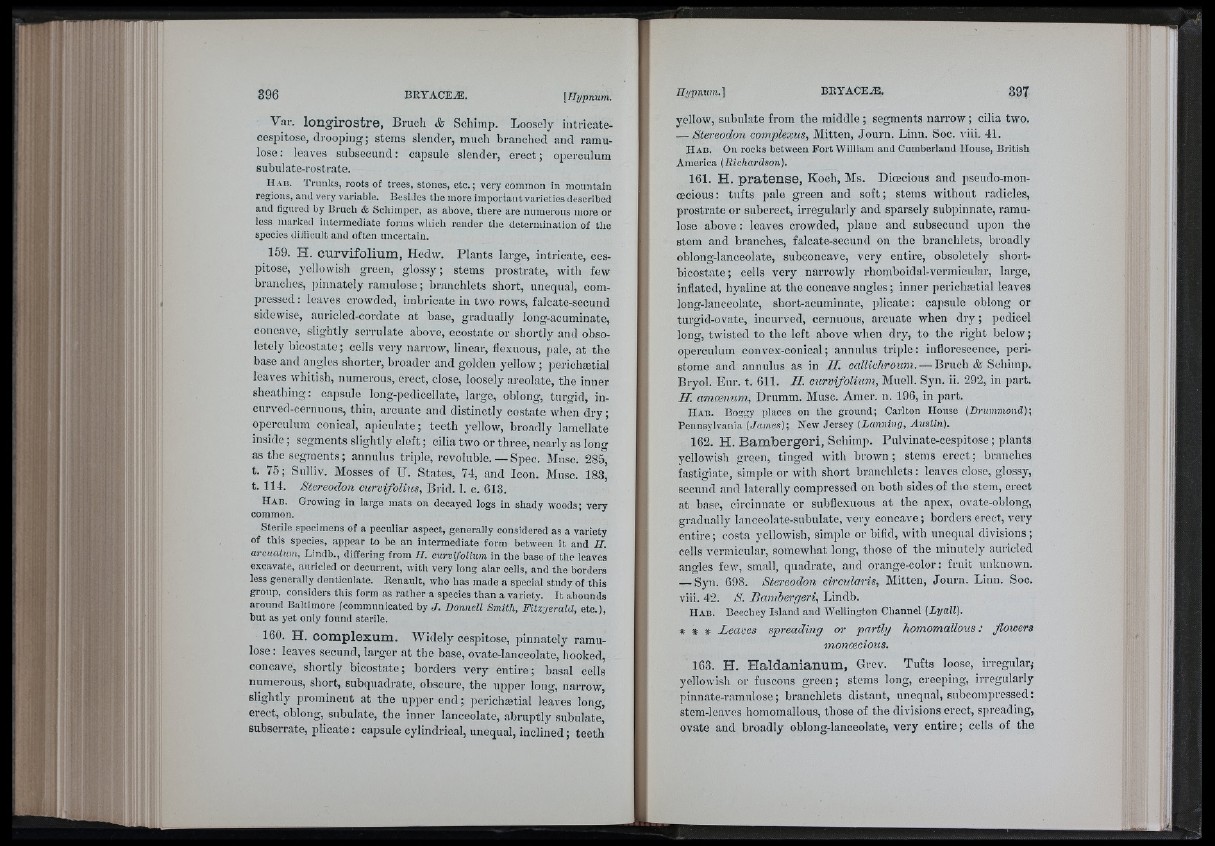
if!
Var. lo n g iro stre , Bruoh & Schimp. Loosely iiitricate-
cespitose, drooping; stems slender, mucli branched and ramulose:
leaves subsecund: capsule slender, erect; operculum
subulate-rostrate.
H a b . Trunks, roots of trees, stones, etc. ; very common in mountain
regions, ami very variable. BesiJes tlie more important varieties described
and figured by Brucli & Scliimper, as above, tliere are luimerous more or
less iiiiirked ¡iilermediate forms wliicU render tlie deteniiinaLioii of tlie
species difficult and often uncertain.
159. H. curvifolium, Hedw. Plants large, inti'icate, cespitose,
yellowish green, glossy; stems prostrate, with few
brandies, pinnately ramulose ; branchlets short, unequal, compressed
: leaves crowded, imbricate iu two rows, falcate-secund
sidewise, aiiricled-cordate at base, gradually long-acuminate,
concave, slightly serrulate above, ecostate or shortly and obsoletely
bicostate ; cells very narrow, linear, flexuous, pale, at the
base ami angles shorter, broader and golden yellow ; perichætial
leaves whitish, numerous, erect, close, loosely .areolate, the inner
sheathing; capsule long-pedicellate, large, oblong, turgid, iii-
curved-cernuoiis, thin, arcuate and distinctly costate when dry;
operculum conical, apiculate; teeth yellow, broadly lamellate
inside ; segments slightly cleft ; cilia two or three, nearly as long
as the segments; annulus triple, revoluble. — Spec. Muse. 28^
t. 75; Sulliv. Mosses of U. States, 74, and Icon. Muse. 183,
t. 114. Stereodon curvifolius, Brid. 1. c. 613.
Hab. Growing in large mats on decayed logs in shady woods; very
common.
Sterile specimens of a peculiar aspect, generally considered as a variety
of this speeies, appear to be an intermediate form between it and II.
arcuatum, Lindb., differing from II. curvifolium in the base of tbe leaves
excavate, auricled or decurrent, witli very long alar cells, and the borders
less generally denticulate. Renault, who has made a special study of this
group, considers tliis form as rather a species than a variety. It abounds
around Baltimore (communicated by J. Donnell Smith, Fitzgerald, etc.),
but as yet only found sterile.
160. H. complexum. Widely cespitose, pinnately ramulose
: leaves secund, larger at the base, ovate-lanceolate, hooked,
concave, shortly bicostate; borders very entire; basal cells
numerous, short, subquadrate, obscure, the upper long, narrow,
slightly prominent at the upper end ; perichætial leaves long,
erect, oblong, subulate, the inner lanceolate, .abruptly subulate,
subsen-ate, plicate : capsule cylindrical, unequal, inclined ; teeth
yellow, subulate from the middle ; segments narrow ; cilia two.
— Stereodon complexus. Mitten, Journ. Linn. Soc. viii. 41.
H a d . Oil rocks between Fort William and Cumberland House, British
America {Richardson).
161. H. p ra te n s e , Koch, Ms. Dioecious and pseudo-mon-
oeoious: tufts pale green and soft; stems without radicles,
prostrate or suberect, irregularly and sparsely subpinnate, ramulose
above : leaves crowded, plane and subsecund upon the
stem and branches, falcate-secund on the branchlets, broadly
oblong-lanoeolate, subconcave, very entire, obsoletely short-
bicostate ; cells very narrowly rliomboidal-vermicular, large,
inflated, hyaline at the concave angles ; inner perichætial leaves
long-lanceolate, short-acuminate, plicate : capsule oblong or
turgid-ovate, incurved, cernuous, arcuate when dry ; pedicel
long, twisted to the left above when dry, to the right below ;
operculum convex-conical ; annulus triple : inflorescence, peristome
and annulus as in II. ccdliehrown. — Brach & SUâm-p.
Bryol. Eur. t. 611. II. curvifolium, Muell. Syn. ii. 292, in part.
II. amoenum, Drumm. Muse. Amer. n. 196, in part.
H a e . Boggy places on the ground; Carlton House {Drummond);
Pennsylvania (Janies); New Jersey (Lamiing, Austin).
162. H. B am b e rg c ri, Schimp. Pulvinate-cespitose ; plants
yellowish green, tinged with brown ; stems erect ; branches
fastigi.ite, sim])le or with short branchlets : leaves close, glossy,
secund aud laterally compressed on both sides of the stem, erect
at base, cireinnate or subflexuous at the apex, ovate-ohlong,
gradually lanceolate-subulate, very concave; borders erect, very
entire; costa yellowish, simple or bifid, with unequal divisions;
cells vermicnlar, somewhat long, tliose of the minutely auricled
angles few, small, quadrate, and or.ange-color : fruit unknown.
— Syn. 698. Stereodon circularis. Mitten, Journ. Linn. Soc.
viii. 42. S. Bamhergeri, Lindb.
H a b . Beechey Island and Wellington Channel (Lyall).
* * * Leaves spreading or partly homomallous: flowers
monoecious.
163. H. H a ld a n ia n um , Grev. Tufts loose, irregular;
yellowish or fuscous green; stems long, creeping, irregularly
pinnate-ramulose; branchlets dist.ant, unequal, snhcompressed:
stem-leaves homomallous, those of the divisions erect, spreading,
ovate and broadly oblong-lanceolate, very entire ; cells of tbe